All?gre Claude J. Isotope Geology
Подождите немного. Документ загружается.


7.4.3 Paleothermometry of intracrystalline isotopic
order/disorder
After the paleothermometry of silicate rocks, one might legitimately ask with hindsight
why the same approach was not adopted for low-temperature paleothermometry and
why several minerals were not used instead of calcite alone to break free of the hypothesis
of a constant value for sea wate r? In fact, research was conducted along these lines and,
for this, the isotopic fractionation between water and calcium phosphate and water and
silica was measure d since these minerals are commonplace in marine sediments and in
parti cular in ¢sh teeth for phosphates and diatoms for silica. Unfor tunately, as
Figure 7.14 shows, while the fractionations are di¡erent for the three minerals (CaCO
3
,
CaPO
4
, and SiO
2
), their variations with temperature are parallel.They may therefore not
be used two-by-two to eliminate the unknown factor which is the isotopic composition
of sea water!
A new method hasvery recentlyemerged to eliminate theunknown quantityofthe isoto-
pic composition of ancient water. It was developed by the new team around John Eiler at
the California Institute of Technology. It isbased on isotopic fractionations existing within
a single molecular species among the di¡erent varieties of isotope (see Ghosh et al.,
200 6b). Let us take the carbonate ion CO
2
3
as an example. This ion comprises num-
erous isotopic varieties:
12
C
16
O
16
O
16
O,
12
C
16
O
16
O
18
O,
12
C
16
O
18
O
18
O, ...,
13
C
16
O
16
O
16
O,
13
C
16
O
16
O
18
O, ..., etc. These are what are cal led i soto pol og s (see Section 7.2.1). Table 7.3
provides an inventory and gives their mean proportions in the ‘‘ordi nary’’carbonate ion.
Each is characterized byadi¡erent molecular mass.
Temperature (°C)
10
3
In α
Δ
-=δ~
A
A
δ
BAB
B
200
24 68
sillimanite zone
garnet zone
biotite zone
chlorite zone
staurotide – kyarite
10 12
400
600
800
1000
Q
u
a
r
t
z
–
F
e
l
d
s
p
a
r
–
A
l
k
a
l
i
n
e
Q
u
a
r
t
z
–
B
i
o
t
i
t
e
Q
u
a
r
t
z
–
M
a
g
n
e
t
i
t
e
Q
u
a
r
t
z
–
M
u
s
c
o
v
i
t
e
-
A
l
k
a
l
i
n
e
Figure 7.13 Isotope temperature of different metamorphic grades determined from pairs of minerals.
After Garlick and Epstein (1967).
389 The paleothermometer
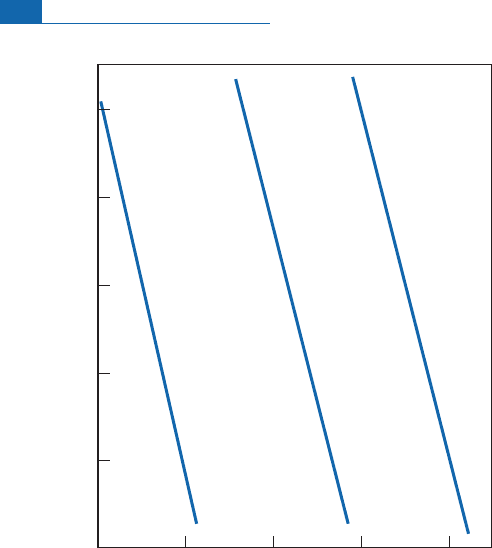
In a calcium carbonate crystal, th ermodynamic equilibria in the sense of Urey occur
among the various isotopic species. Keeping to the most abundant varieties, we can write
the equilibrium:
13
C
16
O
2
3
þ
12
C
18
O
16
O
2
2
,
13
C
18
O
16
O
2
2
þ
12
C
16
O
2
2
:
masses: ð61Þð62Þð63Þð60Þ:
Theequilibriumconstantdependsontemperature.Thelowerthetemperature, the morethe
reaction favors the right-hand members, that is the membersw iththe heavy isotopes ofcar-
b on and oxygen (the most advantaged would be
13
C
18
O
18
O
18
O, but as its abundance is
94 ppt,itcanbarelybem easured).In fact,thisreaction maybeconsideredanorde r/disorder
reaction. The lower the tempe rature, the greater the ordering (light species with light,
h eavy species with heavy).The higher the temperature, the more disordered the assembly
and the equilibr ium constanttends towards unity.
Itis a smartide atous e these equilibriawithinthe calc ite crystal,butthereis a maj ordif-
¢cultyin practice.Calcium carbonateisotopic compositions cannotbe measureddirectly
inthelaboratory(theymaybemeasurableone day with instrumentsforin situisotopeana-
lysis, but for the ti me being they are not precise enough). To measure the isotopi c
+25 +30
Phosphate – water
Carbonate – water
Silica – water
+35 +40
0
10
15
20
25
Δ
18
O = δ
mineral
–
δ
water
Temperature (°C)
Figure 7.14 Fractionation for
18
O/
16
O for various minerals with water. The curve shows clearly that
they are parallel. After Longinelli and Nutti (1973); Labeyrie (1974).
390 Stable isotope geochemistry

composition of CO
2
3
radicals theyare transformed intoCO
2
moleculesbya reactionwith
phosphoric acid.
The breakthrough by the Caltech team was to have developed a technique for extracting
carbonate isotope varieties and transforming them into clearly identi¢able CO
2
molecules
and in particular for distinguishing
13
C
18
O
16
O(mass¼47),
12
C
16
O
16
O(mass¼44),
12
C
18
O
16
O(mass¼46), and
13
C
16
O
16
O(mass¼45) and showing they re£ect the propor-
tions of CO
2
3
molecules (by adding
16
O to each). To do this, they de¢ned the unit
47
betweenthe ratios measured for masses 47 and 44:
D
47
¼ð47=44Þ
sample
ð47=44Þ
reference
hi
10
3
:
Table 7.3 Isotopologs
Mass Abundance
CO
2
16
O
12
C
16
O4498.40%
16
O
13
C
16
O451.10%
17
O
12
C
16
O45730ppm
18
O
12
C
16
O460.40%
17
O
13
C
16
O468.19ppm
17
O
12
C
17
O46135ppm
18
O
13
C
16
O4745ppm
17
O
12
C
18
O471.5ppm
17
O
13
C
17
O471.5ppm
18
O
12
C
18
O484.1ppm
17
O
13
C
18
O4816.7ppm
18
O
13
C
18
O4946ppb
CO
3
12
C
16
O
16
O
16
O60 98.20%
13
C
16
O
16
O
16
O61 1.10%
12
C
17
O
16
O
16
O61 0.11%
12
C
18
O
16
O
16
O62 0.60%
13
C
17
O
16
O
16
O62 12ppm
12
C
17
O
17
O
16
O 62 405 ppb
13
C
18
O
16
O
16
O63 67ppm
12
C
17
O
18
O
16
O63 4.4ppm
13
C
17
O
17
O
16
O 63 4. 54 ppb
12
C
17
O
17
O
17
O 63 5 0 ppt
12
C
18
O
18
O
16
O64 12ppm
13
C
17
O
18
O
16
O64 50ppb
12
C
17
O
17
O
18
O64 828ppt
13
C
17
O
17
O
17
O 64 0.5 ppt
13
C
18
O
18
O
16
O 65 138 ppb
12
C
17
O
18
O
18
O65 4.5ppb
13
C
17
O
17
O
18
O65 9ppt
12
C
18
O
18
O
18
O66 8ppb
13
C
17
O
18
O
18
O 66 51ppt
13
C
18
O
18
O
18
O67 94ppt
391 The paleothermometer
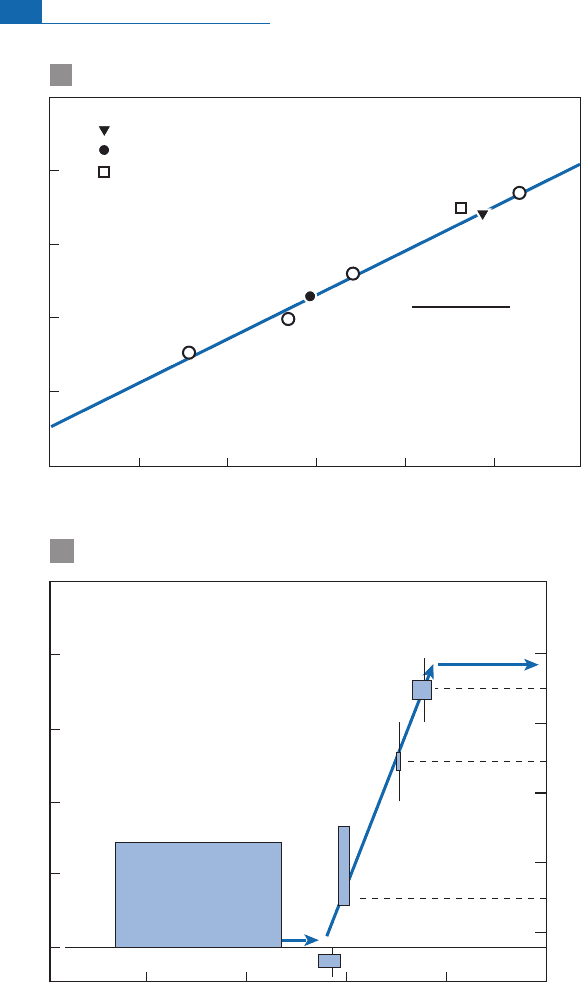
9810 13141211
40407 (Deep sea coral)
Mm97-Bc (Sumatran surface coral)
47413 (Deep sea coral)
0.5
0.4
0.5
0.7
0.8
0.9
10
6
/
T
2
(K)
Δ
47
Δ
47
=
– 0.02
T
2
a
20 1015
Present day
12.5
10
15
20
25
30
17.7
28.4
5
0
1
2
3
4
Age (Ma)
Uplift of the Andes
Altitude (km)
Temperature (°C)
b
Figure 7.15 (a) Calibration of the isotopic order/disorder thermometer with the corresponding
formula. (b) Uplift of the Andes reconstructed by the isotopic order/disorder chemometer. After
Ghosh
et
a
l
.(2006).
392 Stable isotope geochemistry

The reference (47/44) is the ratio that would pertain if the isotopic distribution among the
varietiesof isotopes were purely random.Theyestablished thefractionation curve(
47
,asa
function oftemperature).
The te mperature can therefore be determined from a measurement of
47
. The exact
formula (between 0 and 50 8 C) is:
D
47
¼ 0:0592 10
6
T
2
0:02:
Precision is estimated tobe 2 8C.
An interesting applic ation of this method has been to determine the rate of uplift of
the Bolivian Altiplano. Samples of carbonates contained in soil were taken from the
plateau but of di¡erent ages and dated by other methods. The temperature at which these
carbonatesformedwasthen calculated. As the curveoftemperaturevariationwithaltitud e
inthe Andes is known, the curve ofaltitudeversus time could be d etermined (Figure 7.15 ).
Exercise
Do you think this isotopic order/disorder method could apply to SiO
2
at low temperature
(diatoms)? Write the equivalent equation to that written for carbonate. What would the
isotopic parameter be? Do you see any practical difficulty in this?
Answer
Yes, in principle. The order/disorder equilibrium equation would be:
30
Si
16
O
2
þ
28
Si
18
O
16
O ,
30
Si
18
O
16
O þ
28
Si
16
O
2
mass : ð62Þð62Þð64Þð60Þ
D
64
¼ð64=60Þ
sample
ð64=60Þ
reference
hi
10
3
(or 10
4
as necessary):
The difficulty is that with the present-day method, Si is measured in the form of SiF
4
on the
one hand, oxygen being extracted on the other hand. To apply the method, direct measure-
ment by an
in situ
method in the form of SiO
2
would be required. This will probably be feasible
in the future with ion probes or laser beam ionization.
7.5 The isotope cycle of water
Let us return to the water cycle mentioned at the beginning of this chapter. On E arth, it is
dominatedby thefollowingfactors.
(1) The existence of four reservoirs. A series of exchanges among the ocean, the ice caps,
fresh water, and the atmosphere make up the water cycle. It is another dynamic system.
The reservoirs are of very di¡erent dimensions: the ocean (1370 million km
3
), the ice
caps (29 million km
3
), river water and lakes (0.00212 million km
3
). The transit time of
water in each reservoir varies roughly inversely with its size, each reservoir playing an
importantgeoche mical role.Thus the quantityofwater thatevaporates andprecipitates
393 The isotope cycle of water

is 500 million km
3
per thousand years, or more than one-quarter of the volume of
the oceans.
11
(2) The ocean ^ atmosphere hydrological cycle. Wate r evaporates from the ocean and
atmospheri c water vapor forms clouds that migrate and may occasionally produce
rain.Thus salt water is changed into freshwater and transferred from tropi cal to polar
regions and from the ocean to the landmasses. The hydrological cycle has a double
e¡ect.Clou ds movefromlowtohigh latitu desandalsofromth e oceantothe continents.
The fresh water that falls as rain over the landmasses re-evaporates in part, runs o¡or
seepsin, thusformingthefreshwater reservoirwhichultimately£ owsbacktotheocean.
(3) Thepolarregions.When precipitation from cloudsoc curs inpolar regions,wenolonger
have rain but snow. The snow accumulates and changes into ice forming the polar ice
caps. These ice c aps £ow (like mountain gl aciers, but more slowly) and eventually
breakup intheoceanas icebergs and mix withthe ocean.
Thewholeofwatercirculationontheplanetandthevariousstagesofthecyclehaveb eenstu-
died in terms of isotopes.We have seen, when examining theoretical aspects, that when
water and water vapor are in equilibrium, oxygen and hydrogen isotope fractionation are
associ ated.This double pair of isotopes has allowed us to construct quantitative models of
watercirculation. However, theproblemsraisedby thesestudiesarenotassimpleasthethe-
oreticalstudysuggested.
7.5.1 Isotope fractionation of clouds and precipitation
Acloudisc omposedofwaterdropletsi n equilibriumwithwater vapor.Watervaporanddro-
plets are in isotopic equilibrium. All of th is comes, of cou rse, from water which i nitially
evaporated.
Letus takea cloudnearthe equatorand follow itas itmoves tohigherlatitudes.The cloud
is enriched as a whole in
16
O relative to sea water, as we have seen, an d so has a negative
value. As it moves itdischarges some of itswater as rainfall.The rainwater is enriched in the
h eavyisotope, and so th e cloudbecomes increasinglyenriched in the lightisotope.T he pre-
cipitation is increasingly rich in light isotopes, which e¡ect is o¡set in part by the fact that
thefractionation factorvarieswith1/T.Aswemoveawayfromthe equator,itcanbeseensta-
tistically thattheprecipitation has increasinglynegatived
18
O values (Figure 7.16).
As clouds undergo genuine disti llation, by progressivelylosing their substance, their iso-
tope composition obeys a Rayleigh law, but a‘‘super law’’ because as they move polewards,
thetemperaturefalls,thefractionation factoralsoincreasesanddistillationbecomesincreas-
inglye¡e ctive(Figure7.17) , so much sothatatthe poles the d
18
Ovaluesareextremelynegative.
We observegeographi cal zoning for which the d
18
O value and mean air temperature can
be related(Epstein etal.,1965; Dansgaard and Tauber,1969) (Figure 7.18).
The general cycle of clouds is repeated at local scale, when clouds move over landmasses
andprogressivelyshed their water.Thus, freshwater has negative d values.Thisphenomenon
has been studied using the paired tracers
18
O/
16
OandD/H.Harmon Cra ig of the Scripps
Institution of the University of California showed that rain and snow precipitation and the
11
1km
3
10
12
kg.
394 Stable isotope geochemistry
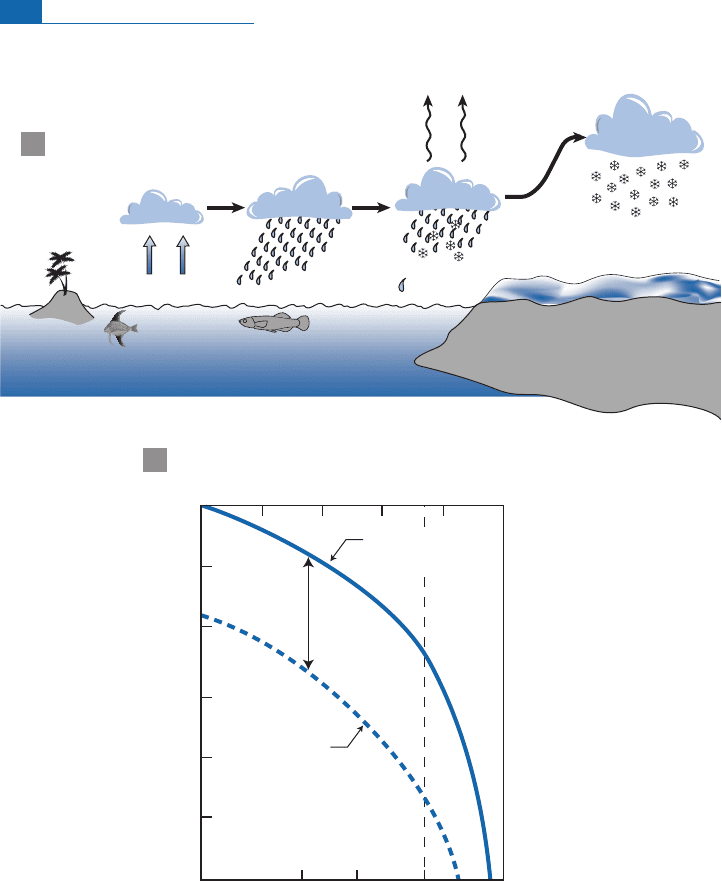
composition ofglaciers lie on what is known as the meteoric water line: dD ¼8 d
18
O þ10
in the (d D, d
18
O) diagram (Figure 7.3). The slope of value 8 corresponds to an equilibrium
fractionation b etween the water and its vapor at around 20 8C. We have good grounds
to think, then, that precipitation occurs in conditions ofequilibrium. It was thought in early
studiesofthe watercyclethatevaporationwasalso statisticallyan equilibriumphenomenon.
In fact, this is notso. Evaporation, which is a k inetic phenomenon in isotopic terms, leadsto
a
b
Subtropical ocean
cooling
cooling
Glacier
heat loss by
radiation
Polar continent
δ = –5δ = –10 δ = –10
δ = –40
cooling
–10
–20
–30
20 15
0.81.0
0.6 0.4 0.2 0.0
010
Temperature (°C)
Fraction of residual vapor
–20
0
Condensed
liquid
10‰
Vapor
δ
18
O (/ ‰)
Figure 7.16 Fractionation of
18
O in a cloud as a function of Rayleigh distillation. The cloud forms at the
equator and moves to higher latitudes, losing water. The fractionation factor varies with temperature.
Modified after Dansgaard (1964).
395 The isotope cycle of water
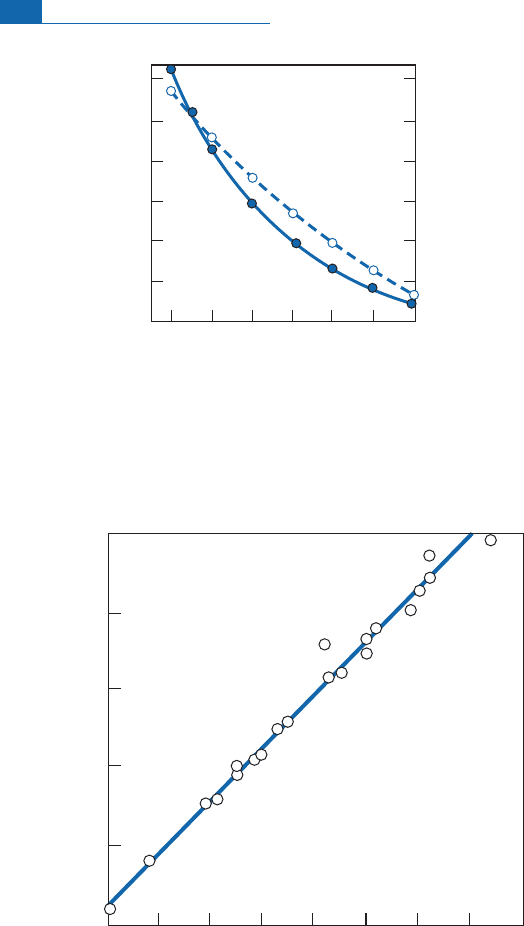
18
O contentsofvapor th at are much lower thanthey would be in equilibrium.Butdepend-
ing on the climate, kinetic evaporation may or may not be followed by partial isotope
re-equilibration which means the vapor composition does not lie on the straight lin e
of precipitation.The same is true, of course, of surface sea water, which forms the residue
of evaporation. Its
18
O composition is variable and depends on the relative extent of
–20 20 40 60 800
1.0140
1.0120
1.0100
1.0080
1.0060
1.0040
1.140
1.120
1.100
1.080
1.060
1.040
Fractionation factor
18
O/
16
O
Fractionation factor
D/H
Temperature (°C)
α
18
α
D
Figure 7.17 Study of
18
O/
16
O fractionation. Liquid–vapor fractionation of H
2
O for
18
O/
16
O and D/H as a
function of temperature. Notice that the scales are different. After Jouzel (1986).
–10
0
–20
–30
–40
–50
–30 –10
Mean annual temperature (°C)
δ
18
O (‰)
+10 +30–50
]
]
Gough Island
Valentia
Dublin
Copenhagen
S. Greenland
N. Greenland
South Pole
66N. Angmagssalik
Goose Bay, Labrador
71N. Umanak
61N. Grennedal
70N. Scoresbysund
75N. Upepnavik
Barbados
Figure 7.18 Variation of the
18
O/
16
O ratio in rainwater and snow with latitude and so with temperature.
After Dansgaard (1964).
396 Stable isotope geochemistry
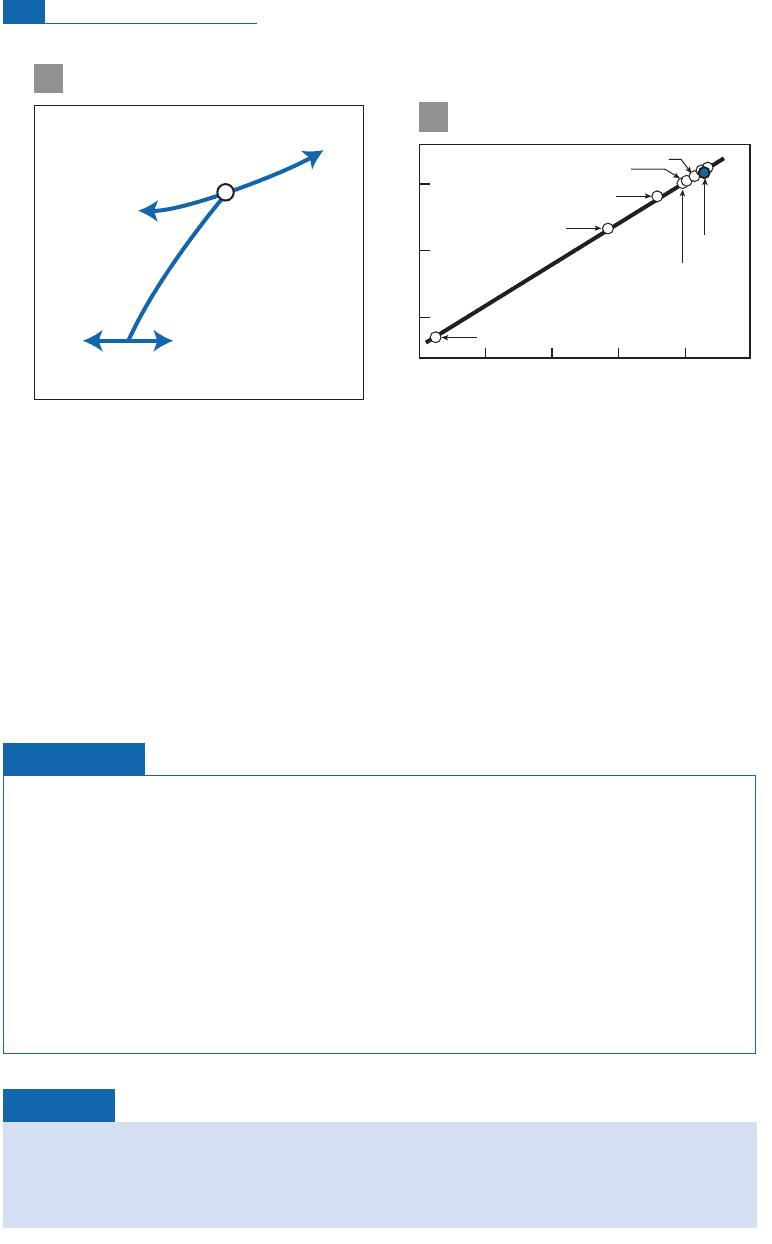
evaporation and of precipitation (which are substantial over the ocean) and of the input of
fresh water. T hese variations are particularly sensitive in the North Atlantic (Epstein and
Mayeda,1953).We visualize thevariations and the in £uence ofthevarious phenomenathat
causes them in a (d
18
O, Sø) plot, where Sø is the salinity ofseawater (Figure 7.19 ). As can
be seen, there is avery close correlation between the two. All ofthis shows thatthis is awell-
understood ¢eldofresearch.
EXAMPLE
Precipitation in North America
This is a map of dD and d
18
O for precipitation in North America (Figure 7.20). From what has
just been said about the effect of isotope distillation of clouds, the pattern of rainfall over
North America is described. The main source of rainfall comes from the Gulf of Mexico with
clouds moving northwards and becoming distilled. This distribution is modified by several
factors. First, the relief, which means the clouds penetrate further up the Mississippi valley
but discharge sooner over the Appalachian Mountains in the east and the Rocky Mountains in
the west. Other rain comes in from the Atlantic, of course, so the distribution is asymmetrical.
Conversely rain from the Pacific is confined to the coast and moves inland little, so the lines
are more tightly packed to the west.
Exercise
From the information given since the beginning of this chapter, use theoretical considerations
to establish Craig’s equation:
d
18
O
¼þ8; d
D
þ10:
E > P
Equator
P
> E
Pole
P
> E
Freezing
effect
δ
18
O
δ
18
O
0
–5
–10
20
25 30 35 40
Salinity (‰)
Salinity
43°N
Norwegian Sea
Gulf of Maine
NADW
35°N
East coast of
Greenland
Off coast of Greenland
a
b
Figure 7.19 Relations between d
18
O and salinity. (a) Theoretical relation. P, precipitation; E, evaporation.
(b) Various measurements for the North Atlantic. NADW, North Atlantic Deep Water. After Craig (1965).
397 The isotope cycle of water
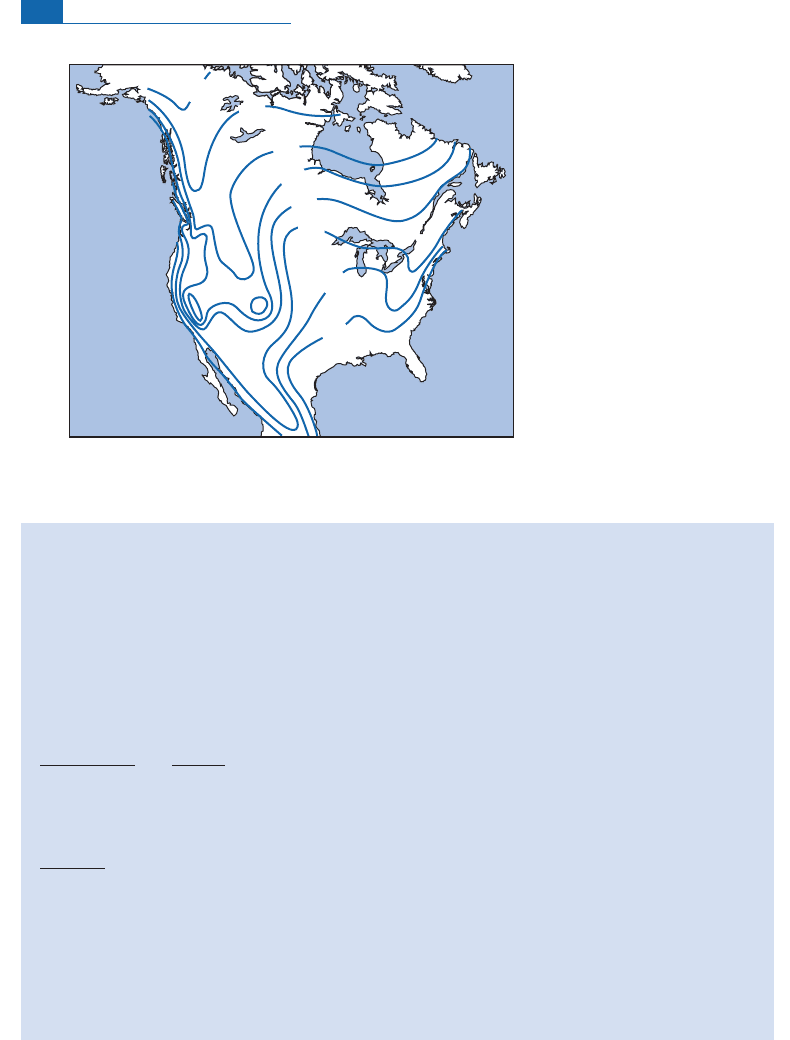
Answer
Clouds obey a Rayleigh law:
d
D
d
D;O
þ 10
3
ð
D
1Þln
f
d
O
d
18
O;O
þ 10
3
ð
O
1Þln
f
:
This simplifies to:
d
D
d
D;O
d
18
O
d
18
O;O
D
1
O
1
:
At 20 8C, as seen in the previous problem,
D
¼1.0850 and
18
O
1:0098, hence:
D
1
18
O
1
8:
We therefore have the slope. The ordinate at the origin seems more difficult to model because
for vapor formed at 20 8 C, d
D;O
8d
18
O;O
¼6:8 whereas we should find 10. We shall not go
into the explanation of this difference, which is a highly complex problem, as shown by Jean
Jouzel of the French Atomic Energy Commission. The different aspects of the hydrological
cycle, including kinetic effects during evaporation, play a part.
7.5.2 Juvenile water
Itiswellknownthatinthewatercycle,th ereis aninputfrom hotwater from thedepthsofthe
Earth. Itwaslongthoughtthat this hot water was th e gradual degassingofwater trapped by
the Earthwhen it ¢rst formed, as with the primitive ocean. If this were so, this water would
p rogressively increase the volume of the hydrosphere.Water from deep beneath the surface
–170
(–22.5)
–150
(–20)
-130
(–17.5)
–110
(–15)
–90
(–12.5)
–70
(–10)
–50
(–7.5)
–30
(– 5)
Figure 7.20 Distribution of
18
O/
16
O and D/H in rainfall in North America. The
18
O/
16
O ratios are in
brackets. After Taylor (1974).
398 Stable isotope geochemistry
